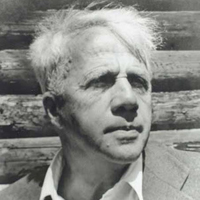Fire and Ice by Robert Frost: Summary and Analysis
Composed in 1919, this poem was published in Harper's Magazine in December, 1920 and in 1923 in his Pulitzer Prize winning book New Hampshire. Fire and Ice is a short lyric of barely 9 lines yet full of meaning. Fire and Ice was inspired by a passage in Canto 32 of Dante's Inferno. This poem is a compression of Dante's Inferno.

Robert Frost (1874-1963)
The poet shows a parallel between the nine lines of the poem with the nine rings of Hell, and makes the structure of the poem, like the downward funnel of the rings of Hell as the poem narrows extensively in the last two lines. Furthermore, the rhyme scheme, aba-abc-bcb, is similar to the one Dante used in Inferno.
The speaker of the poem says that some people agree that the world will end in fire, while some others say that it will end in ice. But from what the speaker has known of desire, he agrees with those who hold that the world is to be consumed by the Great Fire that is the fire of desire. Meanwhile the speaker states, but supposing that the world is likely to end twice, and speaking out of his own experience of the cold of ice that is the hatred, he also agrees that the world will end in ice.
The theme of the poem is the destructiveness of the passions of love and hate. Both these passions are made to look more terrible by understatement. In Thompson's words, "The analogy, here implied, establishes a comparison between the heat of the love or passion and the coldness of the hatred. Coupled with this is the hint of the destructive power of these two extremes of human passion, cataclysmic power. But there is also a further suggestion: these two extremes are made so to encompass life as to be gathering up of all that may exist between them; all that may be swept away by them." Possibly the poem holds out the poet's belief that the opposed extremes most elemental in the long drama of mankind and desire and reason, heart and mind. Symbolically interpreting the poem, fire stands for the heat of love and passion, while ice for the cold of hate. The last line confirms the poet's belief in the two passions possessing enormous destructive power. These passions are inevitable in the drama of human life.
Though the poem is short-sized, it is full of meaning. The poem has been described as "a poem of dry eyed acceptance of both passions in their most destructive form", the two passions being love and hate, which we find detailed herein. Ezra Pound once remarked that there are only two passions worth celebrating in art: love and hate.
Fire and Ice sums up the process of world destruction. It is very close-knit, a glaring example of the style of condensation. Ideas have been packed up into the texture of this poem. The poem Fire and Ice is a masterpiece of condensation. The poem is wrapped up in an epigram speculating about the end of the world. Speaking of the structure of the poem, Thompson observes as follows:
Structurally, such a compact unit, nicely balanced, strikes with the clean accuracy of a poised fist. The backward thrust of "fire" at the end of the fourth line seems to intensify the thought; the paired rhymes in the second half to lead such a natural pause after "great," that the octosyllabic line is permitted to break to give the seemingly internal rhyme after force and permit the laconic understatement of the last three words.
The "laconic understatement" is necessary to make the writing factual and scientific. It is also in keeping with the hard tone of the subject-matter. It adds greatly to the cumulative effect of the poem, making it a real piece of fact and fancy. There is a fine economy of words in it. It is a miraculous poetic piece of few words packed with the profundity of meaning.
In this poem, Frost makes provision for opposite views, as may be deduced from a reading of the poem. He shows himself in agreement with those who believe that the world will end in fire; he is also in agreement with those who believe that the world will end in ice. And this is perhaps the accumulated wisdom of the ages that has taught him to say 'ye' to all that approaches him. On the other hand, this is the quality that stands him in good stead in calling him a 'modern' poet. The 'melancholy dualism' is one of the marked features of modernity. Moreover, it is wise to keep oneself reserved and report everything with the help of such objective phrases as "Some say." The poet does not want to load his beliefs or views upon his readers. He rather vaguely suggests them to entertain the views of others, even if they are diverse and dissimilar.
The poem serves as an analysis of one's life too. If a person is obsessed with unhealthy desires like lust, power, greed, etc., then they will face the fiery end. If a person is jealous and full of hatred, he will demise with the cold that is coldness of love.
Cite this Page!
Shrestha, Roma. "Fire and Ice by Robert Frost: Summary and Analysis." BachelorandMaster, 26 Oct. 2017, bachelorandmaster.com/britishandamericanpoetry/fire-and-ice-summary-analysis.html.
Related Topics
The Silken Tent: Summary and Analysis
The Death of the Hired Man: Summary and Analysis
Neither Out Far nor In Deep: Summary and Analysis
West Running Brook: Summary and Analysis
Stopping by Woods on a Snowy Evening: Analysis
A Considerable Speck: Critical Analysis
Mending Wall: Summary and Analysis
Home Burial: Summary and Analysis
After Picking Apple: Summary and Analysis
The Road Not Taken: Summary and Analysis
Nothing Gold Can Stay: Summary and Analysis
Acquainted with the Night: Summary and Analysis
The Gift Outright: Summary and Analysis
 |
bachelorandmaster.com |